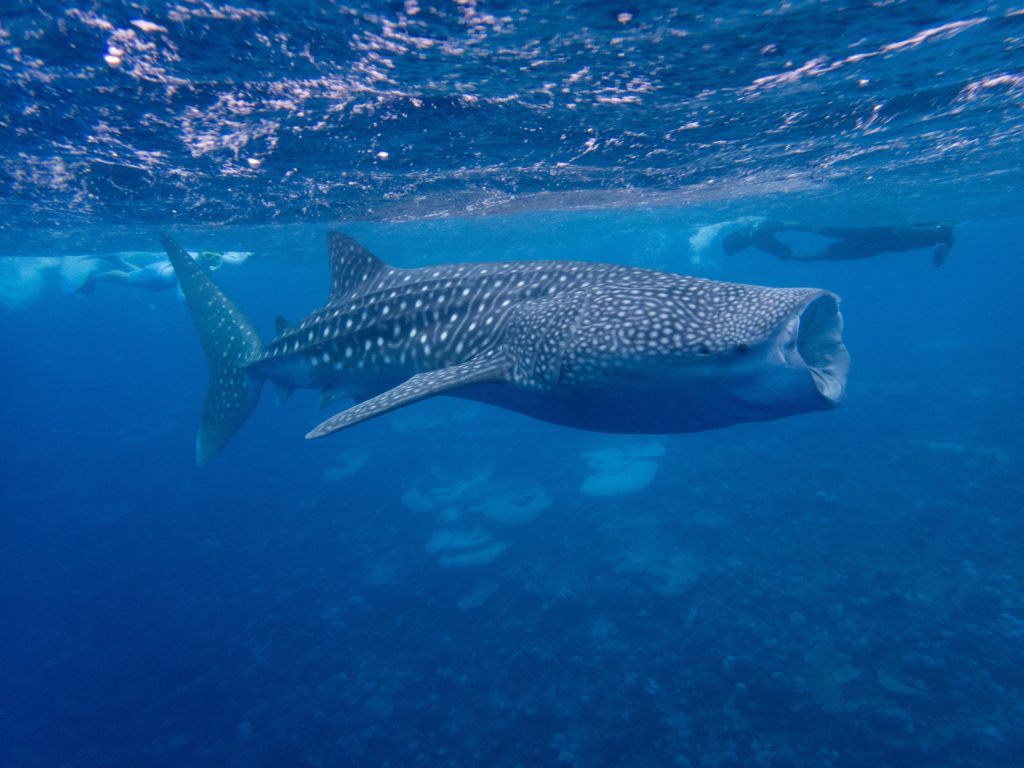As the human population continues to release more and more carbon dioxide into the atmosphere we have to ask ourselves, where does it all go?
Unfortunately most of the CO2 released by fossil fuels is, and will continue to be, absorbed by the ocean. Over time this causes change in the oceans pH levels (known as ocean acidification) and results have dire consequences for many marine species, especially those that use calcium carbonate to build their skeletons – try putting a shell in vinegar. Many of these species contribute directly to the abundance of zooplankton in our oceans, and in turn support and sustain a multitude of organisms across the globe, including whale sharks.
As one of the three known planktivorous sharks in the world, whale sharks are a key indicator species and provide us with a direct means to observe the health of our oceans. However this also means that if their primary source of food is in trouble so are they!
So here are a few ideas we have on how to reduce our carbon output and help protect our oceans and the whale sharks:
- Recycle and Re-use
Recycling is fortunately now widely available in many parts of the world, and local councils go out of their way to make it as hassle free as possible. But there are always ways that you can re-use or breath new life into those everyday objects that you may cast aside. There are thousands of websites and YouTube channels with all sorts of clever hints and tips on how to transform your trash into treasure, some people even make a living out of it! Here are a few ideas to get you going:
Paper Making: Turn your old bills into something new and beautiful, throw in a few pressed flowers or some magazine cuttings to add celebratory colour. A homemade card is always special.
Up-cycled clothing: It’s a sad day when your favourite pair of jeans finally wear through and the holes become just too big for you to continue to pull off the ‘distressed’ look, so why not turn them into a pair of shorts, or a handbag? But if you’d rather avoid the risk of poking holes in your fingers with a needle you could always cut your old clothes into strips and weave them into your very own vintage carpet! or bathmat if you don’t want your friends didn’t comment on it. And if that all still sounds like too much, old t-shirts make great cleaning and polishing cloths!
Tea-light holders: Old tin cans of all shapes and sizes make great tea-light holders. They just need a lick of paint on the outside, a few holes artistically – or not so artistically if your in need of stress relief – punched through them, a bit of sand at the bottom to hold them down and voila! you have your romantic tea-lights ready to go. - Say NO to Plastic!
Plastic kills millions of marine animals every year, and it takes a lot of energy to create! A single-use plastic bottle uses twice as much water as it holds just to be created! In a consumer society plastic is one of the most difficult things to avoid, but you can start helping to solve the problem by removing yourself from it.
Single use plastic bags: Many countries now charge for plastic bags, some have even banned them, but the easiest way to avoid using them is by carrying your own reusable ones with you.
Choose glass not plastic: glass is one of the easiest materials to recycle, so when you’re next out buying your favourite condiment choose the glass jar not the plastic one. When the jar is empty you can ether recycle it or reuse it, they make fantastic containers to freeze all your leftovers in.
Plastic straws: ever seen the video of the turtle getting a plastic straw removed from its nose? Watch it and you will never want to drink through one again. Think about how often you get served a straw with your drink, and then think about how many times that happens every night, and then every week, every year. It’s single-use plastic and if it doesn’t end up in a landfill it goes into the ocean. When you order a drink, ask for it without a straw and if people are interested explain why, you could even petition your local restaurant to stop using them or provide alternatives. Glass and titanium straws are widely available online and are 100% reusable! - Eat Local and Seasonal
Support your local green grocer! As well as supporting the local economy it’s a great way to meet people who live in your area, and shop sustainably as they generally stock local seasonal produce. But if you don’t have that option, then wherever you do shop make sure you read the small print! Food produce is often transported hundreds, sometimes thousands of miles, which all contributes to CO2 emissions. On top of that, in order to survive these long journeys they are often picked too soon and do not have the chance to ripen properly. So for the best taste make sure that what you’re buying is in season and for the lowest carbon history buy as close to home as possible. - Car Pool
Travelling on your own can be a little lonely, not to mention expensive with fuel prices these days – so offset the cost of travel, the dull monotony of freeways, and your carbon output by sharing your journey with someone. Offer to share lifts into work, or arrange your weekly shop with your neighbour, better still, ride a bike! It’s free exercise! - Turn the Lights Off
This is not a suggestion to return to working by candle light, but if your not in a room then there is no need to have the lights on, so switch them off. If you are the last one to leave work them make sure you turn the lights off before you go, and if you work in a building where you know they are left on overnight then ask the manager to consider turning them off, or at lease switching to low-usage bulbs. This will save money, reduce power consumption and therefore carbon output, it will also help reduce light pollution which causes major problems for many species of insect, birds, and even turtles.
Conservation starts with the small choices we make, so don’t be overwhelmed and don’t be afraid! Every little thing counts!
For more information on the oceans role in the carbon cycle and ocean acidification see:
Caldeira, K. and Wickett, M.E., 2003. Oceanography: anthropogenic carbon and ocean pH. Nature, 425(6956), pp.365-365.
Cox, P.M., Betts, R.A., Jones, C.D., Spall, S.A. and Totterdell, I.J., 2000. Acceleration of global warming due to carbon-cycle feedbacks in a coupled climate model. Nature, 408(6809), pp.184-187.
Doney, S.C., Fabry, V.J., Feely, R.A. and Kleypas, J.A., 2009. Ocean acidification: the other CO2 problem.
Sabine, C.L., Feely, R.A., Gruber, N., Key, R.M., Lee, K., Bullister, J.L., Wanninkhof, R., Wong, C., Wallace, D.W., Tilbrook, B. and Millero, F.J., 2004. The oceanic sink for anthropogenic CO2. science, 305(5682), pp.367-371.
Siegenthaler, U. and Sarmiento, J.L., 1993. Atmospheric carbon dioxide and the ocean. Nature, 365(6442), pp.119-125.
NOAA: What is Ocean Acidification
Smithsonian: Ocean Acidification
Natural History Museum: What is Ocean Acidification?
To calculate your carbon footprint visit the WWF Carbon Footprint Calculator


